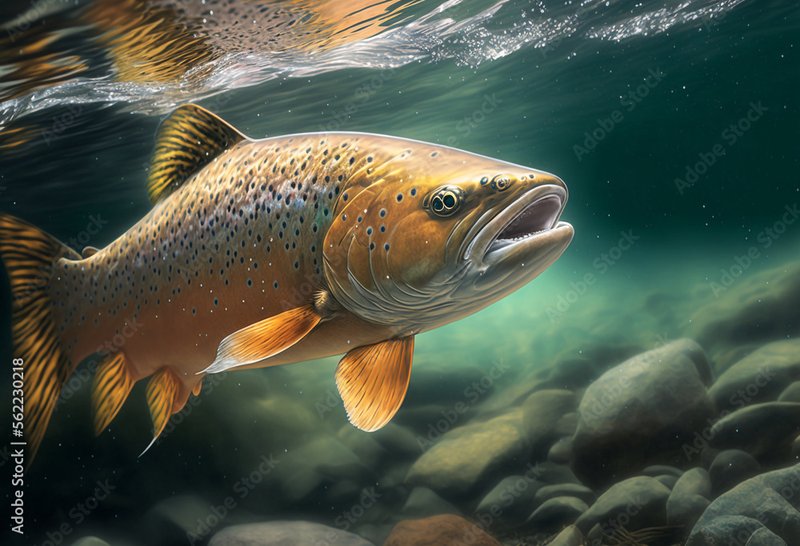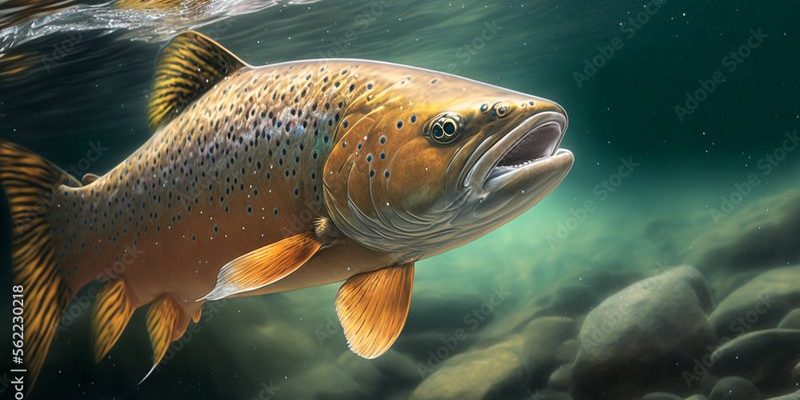
Trout are smart swimmers with fantastic adaptations that help them thrive in their aquatic homes. They might not have the fancy gadgets we do, but they’ve honed their skills over millions of years. Let’s dive into the ways trout navigate their watery environments and how they interact with one another.
How Trout Navigate Their Environments
Trout have some impressive navigation skills. They rely on various sensory cues and instinctual behaviors to find their way through rivers, lakes, and streams. Think of them as having built-in GPS systems that help them travel to feeding grounds or return to spawning sites.
One of the primary ways trout navigate is through scent. Just like how we might follow a familiar smell to find our favorite bakery, trout can detect chemical signals in the water. This ability allows them to locate food sources or recognize the scent of their home stream, guiding them back during spawning seasons.
Another vital sense is sight. Trout have excellent vision, especially in low light conditions. Their eyes are adapted to see well underwater, which helps them spot prey and avoid predators. Interestingly, trout can also see ultraviolet light, a spectrum invisible to humans. This gives them an edge in spotting food that might otherwise blend in with their surroundings.
The Role of Current and Water Temperature
Alongside their senses, trout also use water currents to navigate. If you’ve ever seen a trout darting upstream against a powerful current, you might wonder how they do it. Trout are incredibly strong swimmers, and they can use their fins to harness the current to propel themselves efficiently.
Water temperature is another significant factor for trout navigation. Different species prefer specific temperature ranges. For instance, brook trout thrive in cooler waters, while rainbow trout can tolerate a wider range. By understanding their preferred environments, trout can effectively move to areas where they’re most comfortable.
You might be wondering how all of this ties into survival. Well, navigating their environment correctly helps trout find food, avoid threats, and locate ideal spawning spots. It’s all part of a fishy dance to keep them healthy and thriving.
Communication Among Trout
Now that we’ve covered navigation, let’s talk about how trout communicate. While they don’t have vocal cords like we do, trout are very social animals and have developed unique ways of expressing themselves.
One primary form of communication is through body language. Just like humans can read facial expressions and body posture, trout can understand each other’s movements. For example, a trout that suddenly darts away might signal danger, prompting nearby fish to follow suit.
Another way trout communicate is through chemical signals. As I mentioned earlier, trout can detect scents in the water, but they also release substances called pheromones. During breeding seasons, for example, female trout release pheromones to attract males. This subtle form of chemical communication helps them find mates.
So next time you see trout swimming together, consider that they might be chatting away in their own way, using body language and smells to share information about food or potential threats in their environment.
Understanding the Social Structure of Trout
Trout often create social hierarchies within their schools. You could think of these groups as neighborhoods where everyone has a role. Larger fish tend to dominate feeding areas, while smaller ones hang back to avoid confrontation. This behavior is fascinating because it reflects a social structure similar to many animal societies, even though it might be more basic.
Trout show different behaviors based on their position in this hierarchy. For example, dominant trout might display more assertive swimming patterns, while submissive ones may remain close to the edges, waiting for the right moment to slip in and grab a bite to eat. This social interaction, combined with their navigation techniques, lets trout create a well-organized community.
You might be surprised to learn that some species, like brook trout, can be quite territorial, especially during spawning times. They’ll defend their territory vigorously, using flashes of color and assertive movements to ward off intruders. This territorial behavior is crucial for maintaining the balance within their ecosystem.
How Environmental Factors Affect Navigation and Communication
Environmental changes significantly impact both the navigation and communication of trout. For instance, during heavy rainfall or drought, water levels and currents can change drastically. This can make familiar routes harder to navigate or force trout to adapt to new environments.
Temperature changes, too, play a vital role. If waters warm up too much, trout might become stressed or even inactive, affecting their ability to navigate effectively. They often seek cooler, shaded areas, which might not always align with their usual patterns.
Pollution and habitat destruction can also disrupt trout communication. If chemical signals or scents in the water change due to runoff or sediment, trout might struggle to find food or mates. This can lead to a decline in their populations, highlighting how important it is for us to protect their habitats.
Here’s the thing: when we understand how environmental factors affect trout, we can better appreciate the need to preserve our natural water systems. Their survival depends on a healthy balance in their ecosystems.
Recreational Fishing: Understanding Trout Behavior
If you enjoy fishing, understanding how trout navigate and communicate can give you an edge. Knowing their habits helps you become a more successful angler. Think of it as reading their minds!
When fishing, consider the time of year and water temperature. If the water is cooler, trout are more likely to be active during the day. If it’s warmer, they might prefer the early morning or late evening. By knowing this, you can plan your fishing trips at the right times for better chances of success.
Additionally, understanding their social structure can influence your choice of bait and techniques. For instance, using lures that mimic the movements of prey fish can trigger their instinct to chase. And since trout communicate through body language, observing a group can reveal their feeding patterns and help you determine where to cast your line.
Honestly, it’s all about getting into the mindset of the trout. By aligning your approach with their natural behaviors, you stand a better chance of landing that prized catch.
Trout are remarkable creatures with intricate systems for navigating and communicating in their aquatic world. From their keen senses to their social behaviors, there’s so much more happening under the surface than meets the eye. Understanding these aspects not only enriches our appreciation for them but also highlights the importance of preserving their habitats.
As we continue to enjoy recreational activities like fishing, let’s keep in mind the delicate balance of their ecosystems. After all, trout are more than just a catch; they play a crucial role in maintaining healthy waterways. Next time you’re near a stream or lake, take a moment to appreciate the hidden complexities of the trout’s life, navigating and chatting away in their underwater town.

